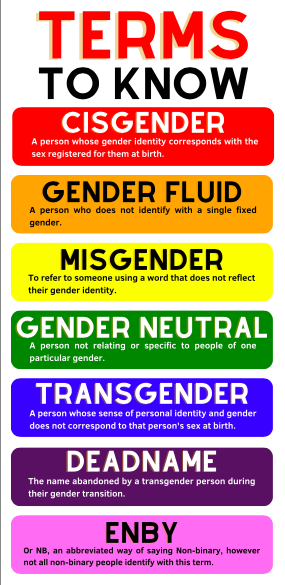Coming out: The transgender community becomes more visible at Cedar
Over the past few years the number of transgender youth has doubled from prior estimates (0.6% of youth over the age of 13 identify as trans as of 2020). Numerous different gender identities are now recognized, many of which fall under the nonbinary umbrella (which falls under the transgender umbrella), including gender fluid, demigirl/boy, gender queer, bi-gender, agender and many others.
The earliest use of the word “gender” was in the 1300s, and the use of the words “man” and “woman” started around 1474. One of the first records of someone identifying as what we would now call nonbinary was the Public Universal Friend, or “the friend.” This idea came about when Jemima Wilkinson fell severely ill in 1776. After recovering, they claimed that they had died and been brought back to life as a genderless person. After this they only responded to gender neutral pronouns and changed their birth name.
Trans people often change their pronouns and name. When a trans person’s old pronouns are used it is called misgendering, and when their old name is used it is called deadnaming.
As gender fluidity becomes more publicly present, issues like misgendering and deadnaming are increasingly important to understand.
Senior Azorion Harper, a trans student who uses she/her pronouns, went through a long process to get where she is now. Growing up, Harper did not always feel like she was in the right body.
“There was a stage where I was nonbinary and went by they/them,” Harper said. “As a kid I always liked girl products and I wanted to mess with girl stuff.”
Although Harper has now found an identity that feels right for her, she still gets misgendered.

“When someone calls me ‘he’ it’s like I don’t know who you’re talking about because I’m not that person,” Harper said.
Senior Ash Plaksin, who uses they/them pronouns, has felt their assigned gender at birth did not represent them since they were very small. It wasn’t until they were a freshman in high school that they discovered the use of they/them pronouns.
Plaksin understands that people might mistakenly misgender them, but they think it becomes an issue when someone isn’t making an effort to stop.
“An accident is an accident until it’s not,” Plaksin said. “If you repeatedly mess up and aren’t making an effort to actually try, it feels the same as not caring.”
Plaksin says that in their experience many teachers are good at recognizing student’s preferred names but struggle with pronouns, though some do try. For example, they had a teacher who sent out a Google form to ask for students’ preferred pronouns and names.
Tara Stuart (she/her), English department, uses a similar Google form query in her classes. She sponsors the Gender and Sexuality Alliance (GSA) club and tries her best to ask people’s pronouns and not misgender them.
“You can see someone’s face light up when they realize that you’re acknowledging them like that,” Stuart said. “Being able to say it out loud and have someone acknowledge it and then repeat those pronouns to them is empowering.”
At other schools she has worked at, Stuart has felt the need to help teachers understand what it feels like to be misgendered or deadnamed. At Cedar she has seen teachers being respectful of students’ preferred names and pronouns.
“As far as I know, when teachers know that a kid goes by a different name or pronoun that they may not have assumed, they respect it,” Stuart said.
Being able to use preferred names and pronouns in school is important for the mental health of trans youth. According to a study in the Journal of Adolescent Health, children and teens who are able to use their preferred name and pronouns in all areas of life have significantly less symptoms of depression (71% decrease), suicidal thoughts (34% decrease) and suicide attempts (65% decrease).
Dr. Shayne Abelkop has firsthand experience seeing the mental health issues that affect trans teens. She has been a licensed psychologist for 18 years and works with children and young adults ages 6-25. Working with people in this age range means she has many patients who are either questioning or transitioning, as puberty is usually the time trans people begin questioning.
Abelkop’s experience working with clients has led her to the same conclusion as Stuart: that using correct names and desired pronouns can benefit trans students.
“One of the tangible ways that people can respect and affirm somebody is to use the name and pronouns that the person is asking them to,” Abelkop said. “We know from research, that when people are respected and affirmed for their gender identity, they have better mental health, their anxiety, depression scores are lower when they feel supported by their family and their school environments.”
Abelkop usually scans for depression and anxiety in her queer and trans patients, acknowledging that LGBTQ+ patients are at an increased risk for mental health issues due to societal standards.
“It’s important that we realize that a trans person walking around will feel stressed, like people are going to reject them,” Abelkop said.
It’s not this way for everyone, however. Abelkop acknowledges that many clients do not experience emotional trauma or anxiety.
“You know, there’s no one universal presentation. I see folks who have no emotional difficulties whatsoever. I have a good number of clients whose only concern is coming out and the process of coming out to their family or school,” she said.
As it’s becoming more common for teens to question their gender identities, the topic becomes more familiar in conversation. But this doesn’t mean it’s always easy for trans students.
“It took a lot of crying and just going through my thoughts and emotions over and over again, but I’m glad I finally met a conclusion,” Harper said.




